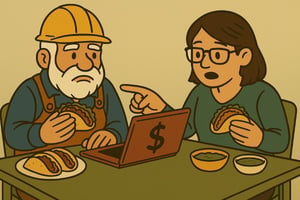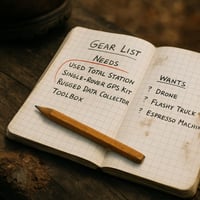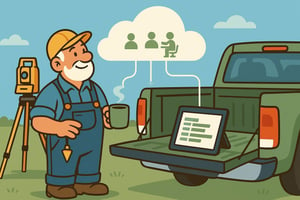Introduction: The Topo That Cost Me My Weekend, My Pride, and Hedge Trimmers Another tale by Gus...
Interview with Gus: First Year Land Surveying Business
Introduction
Here we are again with Gus and his tales from the field… We thought it’d be more fun than another how-to listicle, so we grabbed a couple of lawn chairs, parked ourselves at the back of his pickup, and fired off some questions. Gus keeps it honest—coffee stains and all—while dropping nuggets of startup wisdom for the land-surveyor-turned-business-owner in you.

Q: “Gus, what was the biggest ‘oops’ in your first year?”
Gus: “Oh, we’re starting strong, huh? Alright, here’s my favorite cringe-worthy tale from Year 1:
I get a call to survey a charming little ranch—grass so green it looked like a golf course. I load up my truck at dawn (with precisely one too many cups of coffee), punch the address into my GPS, and head out. Three hours later I’m setting up my tripod, leveling my total station, and thinking, “Wow, this place is bigger than they said.” I sweat through a full morning of work, dash to the nearest Wi-Fi spot, and email the client their “completed” boundary map before lunch.
Cue the text: “Thanks, Gus, but that’s not our property—it’s the Johnsons’ rose garden next door.”
Turns out I’d transposed the house number—21 Maple Drive became 12—so I’d mapped their neighbor’s yard, complete with a perfectly circled koi pond. I sheepishly knocked on the Johnsons’ door, apologized (and accepted free lemonade), then spent the afternoon back on the right plot.
Teaching Moment:
-
-
Always confirm the address and parcel ID with the client and a quick look at the county GIS before you leave home.
-
Run a 5-minute “site orientation”: walk the property, find the corner or mailing address, and snap a photo.
-
Q: “How do you price your services without scaring everyone off?”
Gus: “Ah, the million-dollar question—literally. Years ago, I started with purely hourly rates, then had a client faint when I mentioned ‘60 bucks an hour.’ Now I blend flat-fee quotes for straightforward tasks (like a standard boundary survey) with hourly rates for unknowns timber, mud, or helpful prairie dogs. I factor in overhead—insurance, gas, coffee—and tack on a small cushion ay like 10–15% for the “mystery mud” days). I personally like to break my quote into line items such as “Site Prep: $300,” “Field Work: $450,” “Drafting & Delivery: $250”. Clients see value rather than a scary total. And if you can toss in a quick “This includes two revisions” line, you look like a budgeting genius.”
Q: “Coffee: essential fuel or totally overrated?”
Gus: “Oh, essential fuel—no question. My field mornings start at sunrise, and without coffee I’m about as useful as a compass in a magnet factory. My trusty travel thermos (the one with the lid that never quite clicks) is practically an extra crew member. But here’s where it gets real: too much java turns your hands into human seismographs—try sighting a 0.01-foot measurement with a jittery grip.
So I stick to two strong cups before noon, then switch to water (and the occasional energy bar). I learned the hard way that bottomless mugs from the convenience store add up—now I buy a bulk 12-pack of beans from the local roaster and grind them at home. Plus, splurge on a spill-proof mug; nothing ruins client confidence faster than a coffee waterfall on your field notes. Bottom line: coffee powers the work, but hydration keeps you accurate—and awake.”
Q: “You’ve got equipment costs, insurance, gas—what’s your secret to a real-world startup budget?”
Gus: “Honestly, I run my startup budget like a peanut-butter sandwich—needs on the bottom, wants on top. First, I scribble every tool I might need and circle only those that will help me invoice in the first 90 days, renting everything else until the work justifies ownership. Then I list my “bread” items—insurance, licensing, fuel, core-gear payments—and treat everything else as the jelly I can easily scrape off if cash gets tight. I send invoices before sundown, work out of the garage or the local library conference room, and cancel any software license that sits idle too long. I’ve also tucked away three months’ worth of expenses in a “Rainy-Week Fund,” topping it up with about 10% of profits each quarter. Every Friday afternoon, I eyeball my utilization rate, gross margins, and days-sales-outstanding, tweaking rates or chasing down late invoices before my bank balance turns into an “oops.” And as a final golden rule: if a purchase can’t pay for itself within 18 months, I rent it instead of buying. It’s not glamorous, but it keeps the lights on, the truck rolling, and my sanity intact.”
Q: “What’s your secret to juggling paperwork, fieldwork, and a social life?”
Gus: “My secret weapon is time blocking: Mondays and Tuesdays are ‘field days,’ Wednesdays are reserved for ‘paperwork and plotting,’ and Thursdays are ‘client meetings or catch-up.’ Friday afternoons? That’s ‘off-grid’ time—family, fishing, or a badly needed nap. I use a calendar app with color-coded blocks—blue for field, green for admin, and red for ‘me time.’ It keeps me honest, and if a client wants a Wednesday survey, I know to slot them into Thursday morning or bake in overtime on Tuesday. Bonus: clients love knowing exactly when you’ll deliver. It sets clear expectations—and keeps you from answering emails at 9 p.m.”
Q: “Any advice for scoping out your first big client?”
Gus: “Leverage every connection—ask your old boss, fellow surveyors, even your dentist if they know anyone needing site surveys. Offer a ‘first-job discount’ or throw in an extra topographic sketch for free. Early on, I partnered with a local excavation contractor: I surveyed their jobs at cost, and in return they mentioned me to every new homeowner. Build trust by over-delivering on small jobs—arrive early, send a branded PDF report within 24 hours, and follow up with a quick call: ‘Everything make sense?’ That personal touch turns one-off gigs into repeat business. And always ask for a testimonial—those quotes on your website speak louder than a bulldozer at full throttle. Apply the same logic to big jobs too. Of course you can't provide a PDF report in 24 hours but you get the idea.”
Q: “Final words of wisdom for our budding surveyors?”
Gus: “Embrace the mud, coffee spills, and the occasional client who thinks ‘GPS’ stands for ‘Great Pizza Service.’ Stay curious—attend local trade meetings, read up on new tech, and never stop asking questions. Keep that three-month cushion, price transparently, and treat every job as a demo of what you can do. And remember: if you can’t measure it, you can’t manage it—including your own time and sanity. Now, if you’ll excuse me, I’ve got benchmarks to set, coffee to spill, and a sunset to chase. Go get ‘em, surveyor!”




